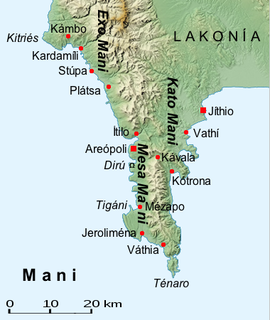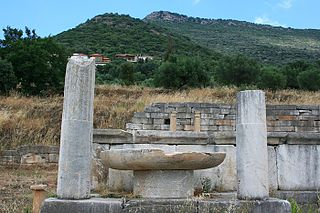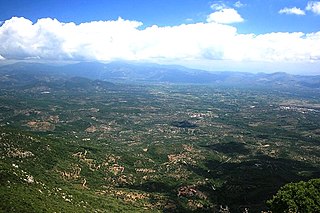
Messene, officially Ancient Messene, is a local community of the municipal unit Ithomi, of the municipality (dimos) of Messini within the regional unit of Messenia in the region (perifereia) of Peloponnese, one of 13 regions into which Greece has been divided. Before 2011 it held the same position in the administrative hierarchy, according to Law 2539 of 1997, the Kapodistrias Plan, except that Ithomi was an independent municipality and Ancient Messene was a local division within it.
Tyrtaeus was a Greek elegiac poet from Sparta. He wrote at a time of two crises affecting the city: a civic unrest threatening the authority of kings and elders, later recalled in a poem named Eunomia where he reminded citizens to respect the divine and constitutional roles of kings, council, and demos; and the Second Messenian War, during which he served as a sort of 'state poet', exhorting Spartans to fight to the death for their city. In the 4th century BCE, when Tyrtaeus was an established classic, Spartan armies on campaign were made to listen to his poetry, and the Suda states that he wrote 'martial songs', probably referring to the chants escorting armed dances and processions during some Spartan festivals.

The helots were a subjugated population that constituted a majority of the population of Laconia and Messenia – the territories comprising Sparta. There has been controversy since antiquity as to their exact characteristics, such as whether they constituted an ethnic group, a social class, or both. For example, Critias described helots as "slaves to the utmost", whereas according to Pollux, they occupied a status "between free men and slaves". Tied to the land, they primarily worked in agriculture as a majority and economically supported the Spartan citizens.

The Mani Peninsula, also long known by its medieval name Maina or Maïna (Μαΐνη), is a geographical and cultural region in southern Greece that is home to the Maniots, who claim descent from the ancient Spartans. The capital citiy of Mani is Areopoli. Mani is the central peninsula of the three which extend southwards from the Peloponnese in southern Greece. To the east is the Laconian Gulf, to the west the Messenian Gulf. The Mani peninsula forms a continuation of the Taygetos mountain range, the western spine of the Peloponnese.
Paeonius of Mende, Chalkidiki was a Greek sculptor of the late 5th century BC. He most likely received his early training in Northern Greece and is thought to have later adapted Athenian stylistic elements into his own work, based upon his probable interaction with the Olympia workshop of Phidias. In any case, he was “attic-trained.”

Aristomenes was a king of Messenia, celebrated for his struggle with the Spartans in the Second Messenian War, and his resistance to them on Mount Eira for 11 years. At length the mountain fell to the enemy, while he escaped and, according to legend, was snatched up by the gods; in fact he died at Rhodes.
The Lelantine War is the modern name for a military conflict between the two ancient Greek city states Chalcis and Eretria in Euboea which took place in the early Archaic period, between c. 710 and 650 BC. The reason for war was, according to tradition, the struggle for the fertile Lelantine Plain on the island of Euboea. Due to the economic importance of the two participating poleis, the conflict spread considerably, with many further city states joining either side, resulting in much of Greece being at war. The historian Thucydides describes the Lelantine War as exceptional, the only war in Greece between the mythical Trojan War and the Persian Wars of the early 5th century BC in which allied cities rather than single ones were involved.

Mount Ithome or Ithomi, previously Vourkano(s) or Voulcano(s), is the northernmost of twin peaks in Messenia, Greece. Mount Ithome rises to about 800 metres, about 760 metres over Valyra, the seat of Ithomi, the former municipality. The other peak is Mount Eva, 700 metres, connected to Mount Ithomi by a thin ridge 0.80 kilometres long.
Pisa was a town, or perhaps an independent district, in Peloponnesus. It included Olympia, the site of the Ancient Olympic Games, and Dyspontium. This area subsequently formed part of the territory of ancient Elis.
In Ancient Greece, the Partheniae or Parthenians were a lower ranking Spartiate population which, according to tradition, left Laconia to go to Magna Graecia and founded Taras, modern Taranto, in the current region of Apulia, in southern Italy.
Teleclus or Teleklos was the 8th Agiad dynasty king of Sparta during the eighth century BC. He was the son of King Archelaus and grandson of King Agesilaus I.
Theopompus was a Eurypontid king of Sparta. He is believed to have reigned during the late 8th and early 7th century BC.

The Spartan army stood at the center of the Spartan state, citizens trained in the disciplines and honor of a warrior society. Subjected to military drills since early manhood, the Spartans became one of the most feared military forces in the Greek world. At the height of Sparta's power – between the 6th and 4th centuries BC – other Greeks commonly accepted that "one Spartan was worth several men of any other state." According to Thucydides, the famous moment of Spartan surrender on the island of Sphacteria, off Pylos, in 425 BC, was highly unexpected. He wrote that "it was the common perception at the time that Spartans would never lay down their weapons for any reason, be it hunger, or danger."
The Second Messenian War was a war which occurred ca. 660–650 BC between the Ancient Greek states of Messenia and Sparta, with localized resistance possibly lasting until the end of the century. It started around 40 years after the end of the First Messenian War with the uprising of a slave rebellion. Other scholars, however, assign earlier dates, claiming, for example, that 668 BC is the date of the war's start, pointing at Sparta's defeat at the First Battle of Hysiae as a possible catalyst for the uprising. Current events concerning this war are stated, too.
The Battle of Deres was a fight between the Spartans and the Messenians which occurred c. 684 BC. It was the first major military engagement of the Second Messenian War. The Spartans and Messenians didn't have any allies at the time of the conflict and the outcome of the battle was highly disputed. Neither side won a clear victory, but Aristomenes is said to have achieved more than it seemed that one man could, so that, as he was of the race of the Aepytidae, the Messenians offered to make him king after the battle. However, he declined the offer, preferring instead to become general with absolute powers.

The First Messenian War was a war between Messenia and Sparta. It began in 743 BC and ended in 724 BC, according to the dates given by Pausanias.

The following outline is provided as an overview of and topical guide to ancient Greece:

Messenia or Messinia was an ancient district of the southwestern Peloponnese more or less overlapping the modern Messenia region of Greece. To the north it had a border with Elis along the Neda river. From there the border with Arcadia ran along the tops of Mount Elaeum and Mount Nomia and then through foothills of Taygetus. The eastern border with Laconia went along the Taygetus ridge up to the Koskaraka river, and then along that river to the sea, near the city of Abia.
Aristodemus was a mythological figure who was a descendant of Heracles.
Lyciscus was the name of a number of people from classical antiquity:







